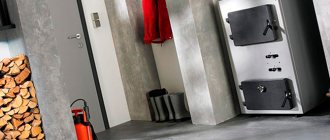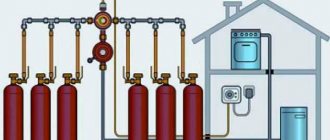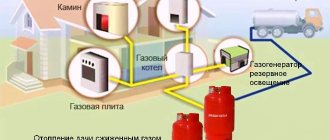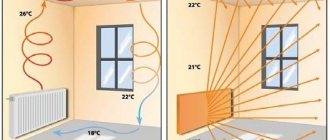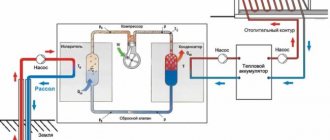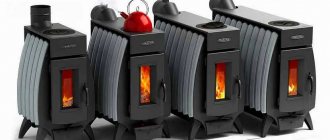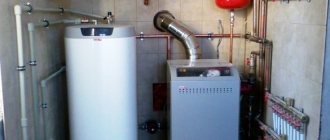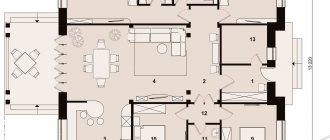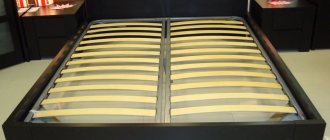Brick houses today still remain one of the most popular buildings. This is understandable. Brick material is strong, reliable and durable. If, of course, you use it efficiently when building a house. Upon completion of construction, an important question arises - which heating system to choose for a brick house.
Before installing the heating of a brick house, let’s clarify one point. Heating installation begins only after you have built the frame of the house, covered it with a roof, installed electrical wiring, plastered the walls and installed a water supply and sewerage system. This order is correct.
Ask why? Installation of heating water supply and sewerage in a brick house must be carried out on smooth walls, which can only be achieved after plastering. Then you will have a beautiful installation and neither the radiators nor the pipes will be covered in plaster.
Now let's move on to the heating options for a brick house.
Water heated floor
Often they began to put warm floors in first place as heating for a brick house. The reason is simple - there are a lot of advantages compared to other heating systems. The only downside is the high cost of installation. It turns out to be about 30% more expensive than a radiator system. But at the same time, heated floors are 30-50% more economical. And the difference in installation costs is recovered on average in 5 years.
If you are planning to install heated floors in your brick house, make sure that the doorways have a clear height of 2050 mm. The heated floor itself ideally takes 14-15 cm of floor height.
Everyone’s financial situation is different and, accordingly, everyone will proceed according to their capabilities. Therefore, if you suddenly decide to save on everything, I will give you wise advice. Whatever you are going to pour under a concrete screed, you need to use the highest quality. Now we are talking about thermal insulation, and this is extruded polystyrene foam with a density of 35. We are also talking about underfloor heating pipes, and this is ideally PEX-A 16mm. But PEX-B, PERT and metal-plastic are also suitable. The main thing is to have a trusted manufacturer.
We have a separate, most useful and detailed video about installing economical and inexpensive heated floors. To receive it, you need to become a reader of our newsletter. You can download the video using this link.
Optimal temperature conditions for a wooden house
Before answering the question of whether to heat a wooden house in winter or not, it is necessary to determine the optimal temperature regime for this type of building. Any professional builder will tell you that it is best to maintain the same operating conditions throughout the entire calendar year. In other words, if the house is constantly +20...22 degrees Celsius, then this will ensure maximum durability of such a building.
However, what if the owners do not plan to visit the house frequently in the winter? Continue to heat, spending considerable financial resources and leaving the heating system operating in automatic mode without control? Obviously, this option is not suitable for all owners of country houses. The reasons for this are obvious - a high level of expenses, essentially useless, as well as an increase in the risk associated with uncontrolled operation of the heating system.
In such a situation, a decision arises to stop heating during the cold weather. In this case, the next question arises about what will happen if you do not heat a wooden house in winter. No matter how strange it may seem, nothing terrible happens in such a situation. The temperature outside and inside the building decreases. This process is accompanied by a decrease in humidity levels, and moisture condenses on surfaces inside the building - on furniture, walls, floors or ceilings.
To understand the essence of the processes taking place, it is important to know that with a sharp drop in temperature, a one-time loss of moisture occurs, which quickly turns into frost. With gradual cooling, this phenomenon occurs slowly and may not be accompanied by any noticeable formation of condensation at all. In both cases, water affects building structures, finishes and furnishings either for a short time or very little.
Based on what has been said, we can draw an obvious conclusion. When heating is stopped during the cold season, especially when certain conservation measures are taken, a wooden house will not suffer any serious negative impacts. Of course, it is best to heat it all year round, however, a break in heating for the winter is not an insoluble problem.
Radiator heating
An equally popular option for heating a brick house. The choice of radiators is also great. My soul lies with steel radiators. Durable, beautiful, difficult to damage and also good heat dissipation.
Alternatives include aluminum, cast iron, and bimetallic radiators. I would not recommend cast iron to you. The last century, large volumes of water in the section and unjustified costs.
The radiator system comes with forced and natural circulation.
The advantages of the forced system are that all pipes can be hidden in the walls; small pipe diameters can be used for wiring. But there is also a minus. Such a system is connected to electricity due to the presence of pumps in the system.
With natural everything is reversed. The pipes come with a large diameter, but they are not dependent on electricity.
What happens in the house in winter if it is not heated?
In winter, the air temperature in our house drops. What is characteristic of cold air? The fact that the amount of moisture in it decreases. It decreases, and significantly! Dozens of times. What happens to the moisture that was in the air while it was warm? Well, she definitely needs to go somewhere! It usually falls out of the air and settles on surrounding surfaces in the form of frost. The frost, by the way, also dries up over time and dryness reigns in our house.
What happens to the body in the cold? It's drying. This is what I remember as a child. I grew up with my grandmother. Grandma was terribly businesslike. This is what I remember now. The whole family depended on her. Moreover, she managed the family according to Domostroi and was the clear head. My parents were hiding from this Domostroy each at their own work, and I had nowhere to hide, so I was exclusively with my granny and I owe my meticulous character, perseverance and determination solely to her. I also inherited from her a fundamental love for Domostroy, but this is not the subject of the article and I am not going to talk about it. Do not worry.
So what am I talking about? Oh yes! Grandmother washed clothes in winter and dried them in the cold. And I kept asking, “Does the laundry dry in the cold? “The grandmother answered that it dries, and very well, and the stronger the frost, the better it dries. I didn’t understand this then, but I believed it, because, as I already said, my grandmother was our leader, and her authority was very great. Now that I myself am already a grandfather (in appearance, not in status) I understand that grandma was right. Things dry out in the cold. The walls are drying, the trim is drying, the furniture is drying. Everything that contained moisture gets rid of this moisture. What happens to a thing when moisture is removed from it? It shrinks a little in size. People say that such a thing has dried up.
Air heating
This is relevant if you have a country house or a house where you rarely visit. There is no water in such a system and, accordingly, there is nothing to freeze when you are away from home for a long time.
Very often such a system can be found in American films. For example, the film "Home Alone".
This heating system for a brick house is a little out of our profile. Therefore, I will not risk delving deeply into it.
How and why does furniture dry out?
Now we can roughly understand why furniture is drying out. Furniture dries out because moisture comes out of it. Evaporates. The components that make up the furniture shrink, dry out, and gaps may form between the pieces. Notice! In order for a thing to dry out, it only needs to freeze and stay in a cold house for a while. Whether you heat your house periodically or not is the second question.
But why does furniture dry out? Because it is made poorly. For example, it is made of wood, which expands very significantly when wet and shrinks just as significantly when dry. Or maybe the furniture is not painted or varnished? Then it will absorb well and dry well and dry out. I had a cute wooden flower stand. It was made in an antique style and was decorated to look like mahogany. Time passed, the varnish evaporated somewhere, and after many years of faithful service the thing dried out completely. On the one hand, it’s a pity, but on the other, it’s his own fault. It was necessary to update the varnish.
When furniture is made with high quality, the boards are carefully selected according to their pattern and structure. A strict selection of materials is used to check for knots and other defects, high-density wood, high-quality adhesives, varnishes and paints are used, and so on and so forth. Such furniture does not dry out. But it also costs a lot of money. This also seems understandable.
Electric heated floors
I put this system in last place for two simple reasons:
- Expensive to operate. Unfortunately, electricity is expensive today and will become more expensive every year.
— We depend on electricity. No electricity. No heat
As the main heating, you should use only cable electric heated floors.
Infrared film can be used for comfortable heating.
Selecting a heating system
Choosing a heating system for a cottage is not an easy task. There are many pros and cons to consider. In this case, it is necessary to consider and analyze the following parameters:
- Fuel availability
- Reliability – the technologies used must be time-tested
- The cost of both the heating system itself and its operation and maintenance
- The prevalence of technologies used to heat a home and the availability of specialists to carry out regular maintenance
- Maintainability
- Appearance and design compatibility
- Individual wishes and their feasibility without loss of overall quality of the heating system
Next, we tried to reveal the main nuances, knowledge of which will help you make an informed choice. If you have any questions, you can always contact us for advice.
Water copper-aluminum convectors
They look very much like radiators and are great for heating a brick house. Mounted exactly the same way. They hang on the walls identical to their radiator brothers. But they differ significantly in properties.
- Convectors work on the principle of convection and warm up the entire room in a matter of minutes. At the same time, heating radiators do this in just over an hour.
- As quickly as convectors heat a room, they cool down just as quickly. It’s hard to call this a minus. But such a property is available in the arsenal. Thanks to these properties, weather-compensated automation becomes useful. Which will automatically regulate the temperature inside the house based on weather conditions.
- Convectors cost 1.5-2 times more than radiators due to the expensive materials used and the manufacturing technology itself.
If you ask me what to choose between radiators and convectors, I will always answer that convectors are better.
Some tips on how to keep warm
If the house has heating radiators, cover the walls behind the radiator with reflective foil. The heat will not warm the wall, but will be reflected from the foil and will heat the room.
If you use gas for heating, be sure to install a gas meter. You will be able to control gas consumption.
We heat the house with wood
Many are looking for an alternative to gas heating. But is it possible to heat a modern house with wood? We are, of course, not talking about the traditional Russian stove on which our grandmothers cooked. Now there are cast iron and steel stoves that can be heated with coal or wood. Outwardly, they resemble the well-known potbelly stove, but have a number of advantages. Let us immediately note that the cast iron construction is more reliable.
Sellers of wood stoves claim that they can heat the entire house and that such heating will be cheaper than gas heating. Can you believe this? In order for such a stove to operate at full capacity, special wood is needed. You will need perfectly dry logs. It is also better to purchase only hard wood. Pine or maple logs will not work. You will have to buy oak or beech wood. Other wood will also burn in this stove, but the heat from their combustion will be much less.
Minuses
Now let's analyze the disadvantages of such heating. The stove will have to be installed in one room, which will heat up as much as possible. Less heat will flow into other rooms. When heating with gas, you distribute the body evenly in all rooms.
By turning on a double-circuit electric boiler, you can not only warm up the house. You will have hot water in the bathroom and kitchen. But you can’t connect wooden heating to a shower stall.
Firewood will have to be stocked and stored in a separate room. To maintain a pleasant temperature in the house, you will have to add firewood several times a day. The ash also needs to be raked out and taken outside.
Now about smoke and combustion products. Ventilation must be provided for them. Otherwise, there will be a threat to health or even life. The stove cannot be left unattended, otherwise a fire may occur if a spark falls on the floor or clothing catches fire from the hot surface.
You can purchase a boiler that runs on compressed sawdust. This stove is expensive, but has several advantages:
- fuel can be added once every 3 days;
- little ash is generated, it can be removed after a week or two;
- the heat transfer of this design is at the level of a wood stove;
- Sawdust cylinders are very light and take up little space.
Candle based heater
Sometimes there is a need to heat only one room or workplace. We can recommend purchasing a Doyle Doss thermal device. The American called his invention “Heat Trap”. The heat source is a burning candle. It turns out that when a candle burns, a lot of heat is generated, but it dissipates.
Coolant
The main types of coolants in heating systems are water, various antifreezes and their mixtures in certain proportions.
Antifreeze is a liquid that is an aqueous solution of ethylene glycol, propylene glycol or potassium acetate with the addition of modifying additives. They lower its freezing point.
Heating a house using a coolant to which special inhibitors are added helps prevent oxidation, corrosion, and scale formation. Their content can range by weight from fractions of a percent to 3-4%.
Which coolant to choose is decided individually, depending on the situation. If the probability of boiler failure is low, there are no problems with fuel, it is better to use water. Many boiler manufacturers prohibit the use of antifreeze, and there are frequent cases of warranty denial on this basis.
